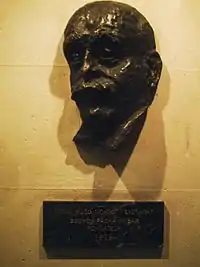Boghos Nubar
Boghos Nubar (Armenian: Պօղոս Նուպար), also known as Boghos Nubar Pasha (Պօղոս Նուպար Փաշա) (2 August 1851 – 25 June 1930), was a chairman of the Armenian National Delegation,[1] and the founder, alongside ten other Armenian national movement leaders, of the Armenian General Benevolent Union (AGBU) on April 15, 1906, becoming its first ever president, a position he held from 1906 to 1928.
Boghos Nubar Պօղոս Նուպար | |
|---|---|
_-_TIMEA.jpg.webp) Boghos Nubar in 1906. | |
| Born | 2 October 1851 Constantinople, Ottoman Empire |
| Died | June 25, 1930 (aged 78) |
| Resting place | Père Lachaise Cemetery |
| Nationality | Armenian |
| Political party | none |

In 1912, he was appointed by Catholicos Gevorg V to head the Armenian National Delegation.[2]
Early life
Nubar was born in Constantinople in 1851. His father was Egyptian Prime Minister Nubar Pasha.
Career
Nubar fought for the Armenian cause.[3]
As early as the beginning of 1912 the Catholicos of Mother See of Echmiazin Gevork V had sent the Boghos Nubar to the Cabinets of Europe with a commission to demand administrative autonomy for Armenians in the Ottoman Empire. He has also been considered as one of the prominent Armenian figures in the Ottoman Empire.[4] This proceeding was a step for Russian and French policy in Constantinople almost at the same moment on March 15, 1913. Boghos Nubar, the ambassador, repeatedly asserts that the Armenians of Ottoman Empire in no way desire to bring up the question of independence or constitutional changes (regarding Armenian National Constitution). Their sole aim is to secure the reforms drawn up by Russia France and England and provided for in the Treaty of Berlin reforms which have remained a dead letter hitherto. In February 1914, the Armenian reform package passed.
In January, 1919, The Times published a letter from Boghos Nubar (an Ottoman citizen) in which he protests, belatedly, about the non-representation of Armenians at the Paris Peace Conference, 1919. The letter includes a useful summary of the Armenian contribution to the allied war effort.[3]
Our volunteers fought in the French Foreign Legion and covered themselves with glory. In the Légion d'Orient they numbered over 5,000 and made up more than half of the French contingent in Syria and Palestine, which took part in General Allenby's decisive victory.
In the Caucasus, without mentioning the 150,000 Armenians in the Russian Armies, about 50,000 Armenian volunteers under Andranik, Nazarbekoff and others, not only fought for four years for the Entente, but after the breakdown of Russia, they were the only forces in the Caucasus to resist the advance of the Ottoman Empire, whom they held in check until the Armistice was signed. They helped the British in Mesopotamia by preventing the ...[5]
Boghos Nubar died in Paris in 1930.
Awards
Boghos Nubar was awarded the Belgian "Ordre de Leopold" and Egyptian Medjidieh, Osmanieh and Nile Orders, honorary degrees and medals for distinguished services[6]
References
- The New Armenia, Volumes 11-12, The New Armenia Pub. Co., 1919, page 63
- Payaslian, Simon (2007). The history of Armenia. New York: Palgrave Macmillan. p. 137. ISBN 9781403974679.
- By Joan George "Merchants in Exile: The Armenians of Manchester, England, 1835-1935" page 184
- Title: Memories of a Turkish statesman-1913-1919, Publisher George H. Doran Company, 1922, page 246
- By Joan George, Merchants in Exile: The Armenians of Manchester, England, 1835-1935, page 184-185
- Nubar and Nubarashem, a publication of the general Directorship of the Armenian General Benevolent Union (Paris, 1929), 5-7.
